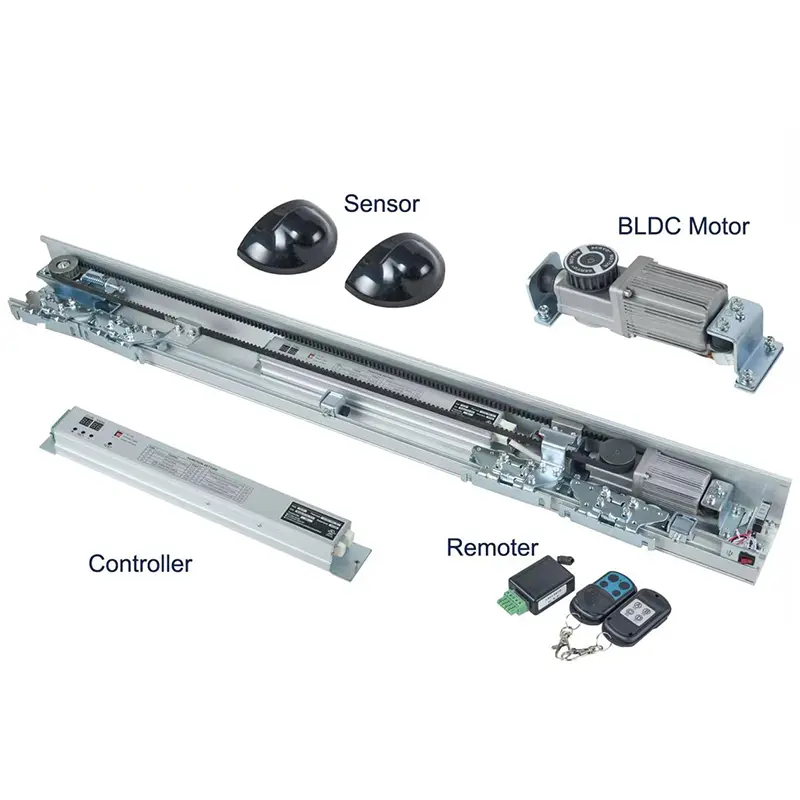The Benefits and Functionality of Automatic Sliding Doors
2024-09-13
Automatic sliding doors have become a standard feature in various modern buildings, from shopping malls and airports to hospitals and office complexes. These doors offer more than just convenience; they also enhance accessibility, safety, and energy efficiency, making them an essential part of contemporary architecture.
In this blog, we’ll explore the benefits, functionality, and various applications of automatic sliding doors, and why they are becoming increasingly popular in both commercial and residential settings.
Why Automatic Sliding Doors Are Important
1. Convenience and Accessibility
One of the most obvious advantages of automatic sliding doors is the convenience they provide. These doors open and close automatically when motion is detected, allowing people to enter and exit without the need to push or pull. This is particularly beneficial in high-traffic areas where hands-free access improves flow and ease of movement.
Additionally, automatic sliding doors improve accessibility for individuals with disabilities, the elderly, and those carrying heavy items or pushing strollers. By eliminating the physical barrier of traditional doors, these automated systems ensure that everyone can access a building with ease.
2. Energy Efficiency
Energy efficiency is a critical concern for modern buildings, and automatic sliding doors play a significant role in reducing energy consumption. Unlike traditional hinged doors that can remain open or be accidentally left ajar, automatic sliding doors open only when needed and close promptly after someone passes through. This reduces the amount of air escaping from the building, helping to maintain indoor temperature and reducing the need for heating or cooling.
In well-designed systems, automatic sliding doors can be integrated with smart energy-saving technologies, such as sensors that detect occupancy or environmental conditions, further optimizing the building’s energy performance.
3. Safety and Security
Automatic sliding doors offer enhanced safety features compared to traditional doors. Equipped with sensors and controls, these doors can detect obstacles in their path and stop or reverse direction to prevent accidents. This is especially important in public spaces with high foot traffic, where the risk of someone being struck by a closing door is higher.
In terms of security, automatic sliding doors can be integrated with access control systems, allowing only authorized personnel to enter restricted areas. This combination of automation and security technology ensures that buildings remain accessible while maintaining a high level of safety and control.
4. Aesthetic Appeal and Modern Design
Automatic sliding doors contribute to the sleek, modern appearance of a building. They create an open, inviting entrance and can be customized to fit the architectural style of any space. Available in a range of materials such as glass, metal, or wood, automatic sliding doors can be designed to complement both contemporary and traditional aesthetics.
The unobtrusive operation of these doors, combined with their smooth motion, adds to the overall user experience and enhances the first impression of a building.
How Automatic Sliding Doors Work
Automatic sliding doors are powered by an electric motor that moves the doors along a track. The system is typically controlled by motion sensors, pressure sensors, or infrared sensors that detect when someone approaches, triggering the door to open. Here’s a breakdown of the main components and how they work together:
1. Sensors:
Sensors are the key to the functionality of automatic sliding doors. Common sensor types include:
- Motion Sensors: Detect movement near the door.
- Infrared Sensors: Use infrared light to detect the presence of people or objects.
- Pressure Sensors: Activate when pressure is applied to a mat near the door.
These sensors communicate with the door’s control system to trigger the opening and closing actions.
2. Electric Motor:
Once the sensor sends a signal, the electric motor engages to move the door. The motor powers a belt or pulley system that moves the door smoothly along a track. Most systems allow for speed adjustments, ensuring the door opens quickly enough for convenience but safely enough to prevent accidents.
3. Control System:
The control system manages the overall operation of the door, ensuring that it opens when someone is detected and closes after a specified time. It can be programmed to control factors like door speed, sensitivity to movement, and the amount of time the door remains open.
4. Safety Features:
Modern automatic sliding doors are equipped with safety mechanisms such as anti-pinch sensors, which stop the door from closing if something is in the way. Some doors also have emergency modes, allowing them to remain open during power outages or fire alarms to ensure safe egress.

Applications of Automatic Sliding Doors
Automatic sliding doors are used in a wide range of settings, each with specific requirements:
1. Commercial Buildings
In shopping malls, hotels, and office buildings, automatic sliding doors improve traffic flow, enhance security, and create a welcoming entrance. Their sleek design complements modern architecture and offers hands-free convenience to visitors.
2. Hospitals and Healthcare Facilities
Automatic sliding doors are essential in healthcare environments, where hygiene and accessibility are top priorities. Touchless operation helps reduce the spread of germs and bacteria, and the wide openings accommodate wheelchairs and hospital beds, ensuring easy access for patients and staff.
3. Retail Stores and Supermarkets
In retail settings, automatic sliding doors make it easier for customers to enter and exit with shopping carts or strollers, creating a seamless shopping experience. They also help maintain indoor temperatures, reducing energy costs for climate control in large spaces.
4. Public Transportation Hubs
Airports, train stations, and bus terminals rely on automatic sliding doors to manage large volumes of passengers efficiently. These doors help streamline foot traffic while enhancing security through integration with ticketing and access control systems.
5. Residential Buildings
While traditionally found in commercial spaces, automatic sliding doors are becoming increasingly popular in high-end residential properties. They offer luxury and convenience, especially in homes with open-plan designs or large patios.
Conclusion
Automatic sliding doors have become an essential feature in modern architecture, providing convenience, safety, and energy efficiency across various sectors. Their ability to create accessible, aesthetically pleasing entrances, while also offering technological integrations for security and energy management, makes them an attractive choice for both commercial and residential spaces.
As technology advances and sustainability becomes more important, automatic sliding doors will continue to play a pivotal role in the future of building design, contributing to smarter, more efficient spaces for everyone.


